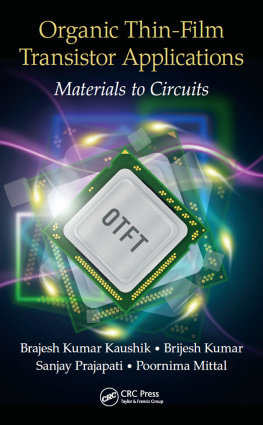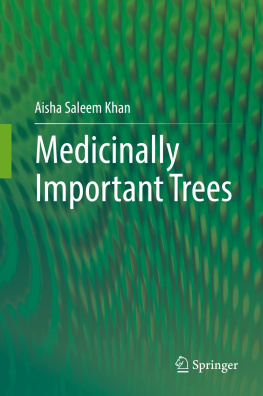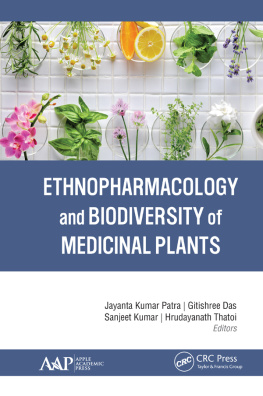Navigation

PHYTOCHEMISTRY OF PLANTS OF GENUS CASSIA
Phytochemical Investigations of Medicinal Plants
Series Editor: Brijesh Kumar
Phytochemistry of Plants of GenusPhyllanthus
Brijesh Kumar, Sunil Kumar and K. P. Madhusudanan
Phytochemistry of Plants of GenusOcimum
Brijesh Kumar, Vikas Bajpai, Surabhi Tiwari and Renu Pandey
Phytochemistry of Plants of GenusPiper
Brijesh Kumar, Surabhi Tiwari, Vikas Bajpai and Bikarma Singh
Phytochemistry ofTinospora cordifolia
Brijesh Kumar, Vikas Bajpai and Nikhil Kumar
Phytochemistry of Plants of GenusRauvolfia
Brijesh Kumar, Sunil Kumar, Vikas Bajpai and K. P. Madhusudanan
Phytochemistry ofPiper betleLandacres
Vikas Bajpai, Nikhil Kumar and Brijesh Kumar
Phytochemical Investigations of GenusTerminalia
Brijesh Kumar, Awantika Singh, and K. P. Madhusudanan
Phytochemistry of plants of GenusCassia
Brijesh Kumar, Vikas Bajpai, Vikaskumar Gond, Subhashis Pal, and Naibedya Chattopadhyay
For more information about this series, please visit: https://www.crcpress.com/Phytochemical-Investigations-of-Medicinal-Plants/book-series/PHYTO
PHYTOCHEMISTRY OF PLANTS OF GENUS CASSIA
Brijesh Kumar
CSIR-Central Drug Research Institute (CDRI), Lucknow, India
Vikas Bajpai
CSIR-Central Drug Research Institute (CDRI), Lucknow, India
Vikaskumar Gond
CSIR-Central Drug Research Institute (CDRI), Lucknow, India
Subhashis Pal
Emory University, Atlanta, Georgia, USA
Naibedya Chattopadhyay
CSIR-Central Drug Research Institute (CDRI), Lucknow, India

First edition published 2022
by CRC Press
6000 Broken Sound Parkway NW, Suite 300, Boca Raton, FL 33487-2742
and by CRC Press
2 Park Square, Milton Park, Abingdon, Oxon, OX14 4RN
2022 CRC Press
CRC Press is an imprint of Taylor & Francis Group, LLC
Reasonable efforts have been made to publish reliable data and information, but the author and publisher cannot assume responsibility for the validity of all materials or the consequences of their use. The authors and publishers have attempted to trace the copyright holders of all material reproduced in this publication and apologize to copyright holders if permission to publish in this form has not been obtained. If any copyright material has not been acknowledged please write and let us know so we may rectify in any future reprint.
Except as permitted under U.S. Copyright Law, no part of this book may be reprinted, reproduced, transmitted, or utilized in any form by any electronic, mechanical, or other means, now known or hereafter invented, including photocopying, microfilming, and recording, or in any information storage or retrieval system, without written permission from the publishers.
For permission to photocopy or use material electronically from this work, access
Trademark notice: Product or corporate names may be trademarks or registered trademarks and are used only for identification and explanation without intent to infringe.
Library of Congress Cataloging-in-Publication Data
Names: Kumar, Brijesh (Phytochemist), author.
Title: Phytochemistry of plants of genus cassia / Brijesh Kumar, CSIR-Central Drug Research Institute (CDRI), Lucknow, India, Vikas Bajpai, CSIR-Central Drug Research Institute
(CDRI), Lucknow, India,
Vikaskumar Gond, CSIR-Central Drug Research Institute (CDRI), Lucknow, India, Subhashis Pal, Emory
University, USA, Naibedya Chattopadhyay, CSIR-Central Drug Research Institute (CDRI), Lucknow, India.
Description: First edition. | Boca Raton : CRC Press, 2021. |
Series: Phytochemical investigations of medicinal plants |
Includes bibliographical references and index.
Identifiers: LCCN 2021019442 (print) | LCCN 2021019443 (ebook) | ISBN 9781032030210 (hardback) |
ISBN 9781032030227 (paperback) | ISBN 9781003186281 (ebook)
Subjects: LCSH: Cassia (Genus)--Analysis. |
Cassia (Genus)--Therapeutic use. | Medicinal plants.
Classification: LCC QK495.C1153 K86 2021 (print) | LCC QK495.C1153 (ebook) | DDC 633.8/34--dc23
LC record available at https://lccn.loc.gov/2021019442
LC ebook record available at https://lccn.loc.gov/2021019443
ISBN: 978-1-032-03021-0 (hbk)
ISBN: 978-1-032-03022-7 (pbk)
ISBN: 978-1-003-18628-1 (ebk)
DOI: 10.1201/9781003186281
Typeset in Times
by MPS Limited, Dehradun
Table of Contents
Plants are considered to be one of the most important sources of modern medicine. They have been used globally for a variety of ailments since the beginning of civilization. Bioactive secondary metabolites have been considered as a fundamental source of medicine for the treatment of a range of diseases in modern medical system. India has a rich heritage of medicinal plants, Ayurveda, Siddha, Unani, Homoeopathy and Naturopathy. In India, about 60007000 plant species are utilized in traditional, folk and herbal medicine. Herbal medicines/formulations are prepared using crude or processed plants having several active constituents. Knowledge of the phytochemical composition of crude drugs is a very critical aspect in the preparation, safety and efficacy of the herbal product. Identification and determination of the active constituent are now important and crucial prerequisites for the development of modern evidence-based phytomedicine. The use of medicinal herbs or herbal drugs is increasing throughout the world, though one of the main encumbrances in its global acceptance is the lack of quality control or standardization for the establishment of consistent pharmacological activity. A reliable chemical profile or simply a quality control program for the production of herbal drugs can serve the purpose.
Cassia is an indigenous plant in Africa, Latin America, Northern Australia and Southeast Asia. Several Cassia species are of highly commercial and medicinal significance since they are used as spices and in traditional medicines. Some of the most widely recognized species of this genus are Cassia auriculata, Cassia fistula and Cassia occidentalis followed by Cassia siamea and Cassia uniflora. Cassia species are reported to have various pharmacological activities such as antibacterial, analgesic, anti-inflammatory and antiarthritic, hepatoprotective, antitumor, antifertility, antifungal, antioxidant, antileishmaniatic, antimicrobial, CNS and hypoglycaemic activity. Different class of compounds reported from Cassia species are anthraquinones, phenolics, flavonoids, chromenes, terpenes, proanthocyanidins, coumarins, chromones and lignans. The taxonomy and nomenclature of Cassia species are quite complex. It is very difficult to differentiate them due to their overlapping morphological characters and close similarities, which usually leads to misidentification and misinterpretation of the components. Genus Cassia is in great demand due to its medicinal properties.
Recently, mass spectrometry has played a central role in the field of plant metabolomics. It facilitates efficient analysis of metabolites in the complex matrix of plant extracts due to high sensitivity, selectivity and versatility. LC coupled with tandem mass spectrometry detection (LC-MS/MS) is a sensitive, selective and efficient technique for the comprehensive qualitative and quantitative analysis of plant metabolites. The work contained in this book includes development of a qualitative HPLC-QTOF-MS method to identify 24 phytochemicals in CO extract and validation of a rapid and sensitive UPLC-QqQLIT-MS/MS method for simultaneous determination of eighteen bioactive compounds in different plant parts of five










